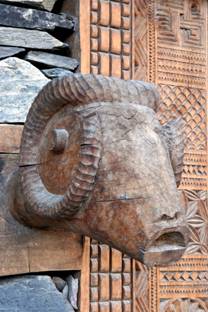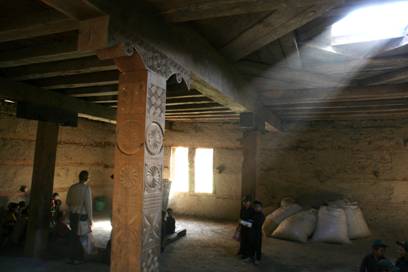Being of Armenian parentage, I had got used to seeing this symbol used in medieval Armenian art.
 |
| On a Khatchkar, Etchmiadzin, Republic of Armenia |
 |
| Gandzasar Cathedral, Republic of Nagorno-Karabakh |
 |
| Outside of a Church in the Kanaker district of Yerevan, Republic of Armenia |
 |
| Noravank, Republic of Armenia |
 |
| Noravank, Republic of Armenia |
 |
| Saint Gregory Cathedral, ruined city of Ani, Republic of Turkey |
 |
| Tatev monastery, Republic of Armenia |
 |
| Outside of a Chapel, Yeghegise, Republic of Armenia |
I recalled browsing a book that featured a plate of a sarcophagus, in "
Kafiristan", Afghanistan, that featured the "Eternity" symbol.
However, recent attempts to find any images online brought nought.
Being a member of the British Museum, I get their quarterly magazine.
For the Spring/Summer issue of 2014 they featured a section on the "
Gandau" statues used by the
Kalash people, living in the Chitral valley of modern-day Pakistan.
Below is a photo from the said issue of the magazine, page 51, the photo is by Luke Rehmat:
Notice the similarity of the symbol used on the Gandau statue on the right, to the "Eternity" symbol used in medieval Armenian funerary and Church art.
Another example of this pair of Gandau, from the website
pakwheels.com
Another pair of Gandau from the same website:
Below is from the website davecullen.com, showing a an image that features sarcophagii of the Kalash people:
Compare with another look at my photo of the outside of the dome of the Cathedral of Saint Gregory, in the ruined city of Ani, today in the Republic of Turkey:
Below is from the website
madamepickwickartblog.com
 |
| The Goat Sacrifice to Sajigor-Shura Verin-Indra, the "kafir" God of Power, Wealth and Fertility |
View of the inside of the Temple for Kalash men, from the website
kjti.co.uk
The Kalash tribe, around 2,000 strong, survive
in the remote Chitral valley of north-west Pakistan. Formerly sharing
much in common with neighbouring peoples in the "Kafiristan" region of
Afghanistan, until those people were forced to convert
to Islam in the late 19th century by the Emir of Afghanistan, who
renamed the region "Nuristan".
Also in the 19th century came about the
myth that the Kalash people come from "Alexander the Great".
Up until then, they had
never claimed such descent, it was the British Scholar, G. S. Robertson (An Inquiry Into The Ethnography Of Afghanistan, 1891, by H. W. Bellew & G. S. Robertson) who made the link to Alexander the Great.
Recent genetic testing has shown that the Kalash people have Indo-Iranian, rather than Macedonian or Greek genetic ancestry.
If there is any remote link between the Kalash
people and Armenia, it may derive from Armenians being deported to the
remotest parts of Khorasan (Afghanistan) during the era of the Sasanid
Persian Empire, for example during the reign or Shah Yazdegerd II, or from a far older Avestan connection.









































